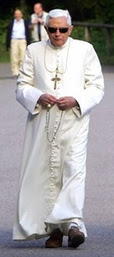Even at Papal Masses, the readings before the Gospel are read by laypersons, not by vested, instituted lectors (of whom surely a supply would be available in Rome of all places); even at Papal Masses, despite several deacons serving at the Pope's side, the Prayers of the Faithful are read by a troop of layfolk, each reading one petition (just as teachers love to arrange a set of students to read them at school Masses), rather than – as all tradition would suggest, not to mention the rubrics – have a deacon announce the intentions for which to pray.
At least at Papal Mass in St Peter's, the Supreme Pontiff is celebrating Mass facing East, given the orientation of that basilica!
At least the Holy Father has brought back the use of an altar rail, at which, to kneeling communicants, he administers the Bread of Life, placing the Sacred Host on their tongues (and, one assumes, a following deacon then gives them Christ's Blood from the chalice).
It seems to me that, if a resacralization of the celebration of Mass is to be attempted – as is most needful, and moreover as the Pope has emphasised – then some of the first things to be done are to bring back a better adherence to the spirit of liturgical law, rather than, out of a misplaced sense of "community involvement", have members of the congregation perform what should be the proper ministries of lectors, acolytes and deacons: therefore, readings and intercessions should be read by persons vested at the least.
Almost more than anything else, restoring the ancient and rational practice of the priest facing East, standing before the altar, leading the people in prayer, rather than foolishly gawping at them (and they him) across the table thereof, is to be desired and worked towards. The few times I've had the joy of attending Ordinary Form Mass said ad orientem, it has greatly helped make clear that what is going on is and ought to be offered as a reverent, dignified, sublime sacrifice. It helps the priest pray, and helps both him and his flock focus on the Mystery, rather than both be distracted by and distracting to each other.
It seems to me that the administration of Holy Communion should be restored to being a more reverent ritual, with those doing so, even if EMHC's, being at least parati (vested), and those receiving kneeling to do so, as is the Papal preference.
Again, none of all of this requires any change in rubrics – only the resolve to implement, not a vulgar minimum, but a maximum.
Hence:
- Readers should be vested, instituted lectors;
- A deacon if present, or such a lector, should read the General Intercessions;
- Mass should be said employing the Eastward Position;
- EMHC's, if their use actually be necessary, should be vested;
- Communion should be received kneeling.
Why it is – as Acts of the Martyrs in North Africa demonstrate – that country congregations in the early Church had multiple lectors, subdeacons and so forth, where all too often to-day some aged priest has no servers but only a bevy of middle-aged ladies come to assist in reading and later in distributing Communion, I wonder?
(For the moment I do not speak of the parallel calls, now ever-stronger, for a return to singing the whole Mass, and the Propers thereof, not ditties or hymns but Introits and so forth.)
******
I will make one suggestion of a profitable and easy change to the modern Order of Mass: rather than having three Penitential Acts, all three ought be merged together: thus, the priest would always begin with the introductory phrase Fratres agnoscamus peccata nostra, then lead all in the Confiteor, which he answers with the Misereatur (all responding Amen) – then, having used "Act A", he would at once continue with the versicles that comprise variant "B", which form a sensible bridge to the Kyrie, either untroped, or (as in Penitential Act C) with interpolated verses (a nice revival of a mediæval practice).








No comments:
Post a Comment